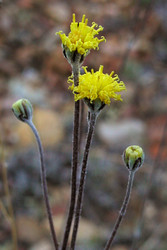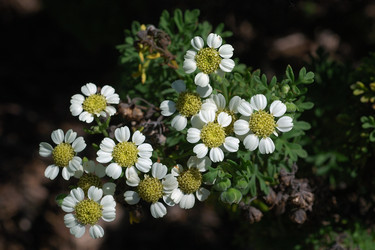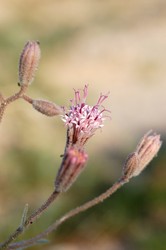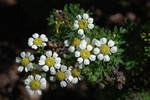Bahieae



This tree diagram shows the relationships between several groups of organisms.
The root of the current tree connects the organisms featured in this tree to their containing group and the rest of the Tree of Life. The basal branching point in the tree represents the ancestor of the other groups in the tree. This ancestor diversified over time into several descendent subgroups, which are represented as internal nodes and terminal taxa to the right.

You can click on the root to travel down the Tree of Life all the way to the root of all Life, and you can click on the names of descendent subgroups to travel up the Tree of Life all the way to individual species.
For more information on ToL tree formatting, please see Interpreting the Tree or Classification. To learn more about phylogenetic trees, please visit our Phylogenetic Biology pages.
close boxReferences
Baldwin, B. G., B. L. Wessa, and J. L. Panero. 2002. Nuclear rDNA evidence for major lineages helenioid Heliantheae (Compositae). Syst. Bot. 27: 161-198.
Karis, P. O. 1998. Apostates Lander (Asteraceae-Astereae) transferred to the Heliantheae sensu lato. Bot. Jahrb. Syst. 120: 131-135.
Panero, J. L. 2007. Compositae: tribe Bahieae. Pages 433-439 in Families and Genera of Vascular Plants, vol. VIII, Flowering Plants, Eudicots, Asterales. Kadereit, J. W., C. Jeffrey (eds.), Springer-Verlag, Berlin.
Robinson, H. 2002. Holoschkuhria, a new genus of the Hymenopappinae (Helenieae) from Peru. Comp. Newsl. 38: 47-51.
Title Illustrations

| Scientific Name | Hymenopappus filifolius |
|---|---|
| Location | Baldwin Lake Reserve, San Bernardino Mountains, California, USA |
| Specimen Condition | Live Specimen |
| Source | Hymenopappus filifolius |
| Source Collection | Flickr |
| Image Use |
 This media file is licensed under the Creative Commons Attribution-NonCommercial-NoDerivs License - Version 2.0. This media file is licensed under the Creative Commons Attribution-NonCommercial-NoDerivs License - Version 2.0.
|
| Copyright | © 2006 Wayfinder_73 |
| Scientific Name | Bahia ambrosioides |
|---|---|
| Location | cultivated at UC Berkeley Botanical Garden, native to Chile |
| Specimen Condition | Live Specimen |
| Source | Bahia ambrosioides |
| Source Collection | Flickr |
| Image Use |
 This media file is licensed under the Creative Commons Attribution-NonCommercial-NoDerivs License - Version 2.0. This media file is licensed under the Creative Commons Attribution-NonCommercial-NoDerivs License - Version 2.0.
|
| Copyright | © 2005 Eric in SF |
| Scientific Name | Palafoxia arida |
|---|---|
| Location | southwestern Imperial County, California, USA |
| Specimen Condition | Live Specimen |
| Body Part | flowers |
| Source | Palafoxia arida |
| Source Collection | Flickr |
| Copyright | © 2008 squamatologist |
About This Page
Page copyright © 2011
All Rights Reserved.
- First online 04 April 2008
- Content changed 03 July 2011
Citing this page:
Tree of Life Web Project. 2011. Bahieae. Version 03 July 2011 (temporary). http://tolweb.org/Bahieae/22920/2011.07.03 in The Tree of Life Web Project, http://tolweb.org/











 Go to quick links
Go to quick search
Go to navigation for this section of the ToL site
Go to detailed links for the ToL site
Go to quick links
Go to quick search
Go to navigation for this section of the ToL site
Go to detailed links for the ToL site